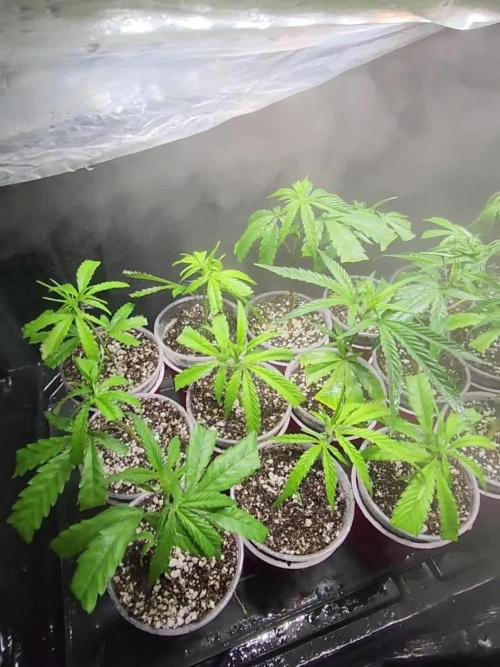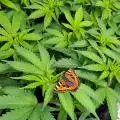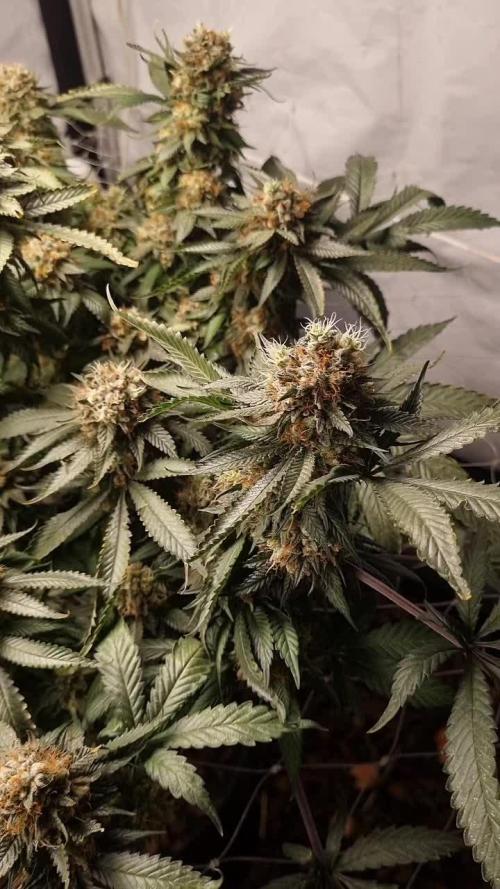The Grow Awards 2026 🏆 





























Likes
14
Share


@BruWeed
Follow
🍀Estuvo bien en toda su etapa, no tuve ningún problema. Los resultados fueron muy buenos, se encuentra muy resinosa y con aroma a dulce.
🍀En total saque 143g de una sola planta.
🍀En total estuvo 105 días de vida desde su germinación.
🍀Recomiendo esta genética, por el momento son cocos Premium, ya quiero probarlo para saber que sabor tiene.
🍀Ahora se encuentra en etapa de secado, cuando ya estén para la etapa de curado subiré más imágenes.
🍀🇦🇷Podes seguirme en Instagram como @bruweed_arg🍀🇦🇷
Likes
4
Share


@GREENPHOENIX6262
Follow
09/07 - Reveg still in process - Mother plant in recover from clone clipping - unhealthy clones disposed - cutting new clones this week - Myco and Superthrive feed increased - Net dropped an LST.
Likes
6
Share


@Prof_Weed
Follow
Removed 2 leaves.
Has got a little bit of deficencies, i think the pot is to small, not easy to feed..
But Overall happy!
Likes
19
Share


@Chi_K24
Follow
Alright folks! We are running on aprox Day30 into the grow! The tallest plant almost stands up 18+ inches! Shes growing good, I do have one plant that is being all funny and its showing me excessive signs of nutes. Added Calmag feeding @ 3mL/Gal and watered each plant about 2L each. Pots were dryish, been 8 days since the last watering. (i think its a bit too long for airpots, but plants seem to be ok) This week just adjusted some of the LST ties so the plant can stretch a bit. Also did a very light defoliation (removing dead leaves) and allot of tucking. I replaced the Vivosun Osc Fan due to a reddit post i saw of one being burnt to a crisp, replaced them with the HoneyWell turbo force fans. So far so good. Also moved one of the main fans to the side of the tent trying to setup a cross draft air circ.
I have also noticed that the plant is now in pre-flowering and some very nice aromas coming from the plant. (green/Citrus/Sweet) notes. It quite pleasant to be in the tent! :)
Likes
59
Share


@Rap_a_cap
Follow
Great climate, ideal. After careful consideration, valued the considerable size of the plants, the flowering stage and the yellowing of the bottom canopy , I decided to feed one last time with veg nutes at half dose. This will be followed by 2 waterings of water only and then a boost of flowering nutrients.
Here we are. It happened overnight, nothing the night before, the next morning there are pistils everywhere. Looking at the structure of the branches , I think they will be monstrous buds. Stay tuned for a monster crop. This beast is insanely hungry of nutes. For now absolutely pests-resistant.
Thanks for following, I ❤️ you
Processing
Likes
6
Share


@Silverback_Guerilla
Follow
11/3:
Her new growth looks better, but her old foliage looks pretty rough...hope the leaves last long enough to make the energy she'll need to swell those buds...
She's dry already today, but I'll water tomorrow.
11/4:
I sprinkled a tablespoon of Cave Culture (bat and seabird guano) over her soil and watered it in with 1/2 gallon including humic acid, myco/tricho/beneficial bacteria, bembe, terpinator, and cal-mag.
11/5:
I just ogled her and rotated her a couple times today.
I removed the oscillating fan from above my lighting so that I could raise the lights several more inches, and added another oscillating fan above the lights that blows down on the plants.
The one I removed is still up there too, but blowing across the LED drivers and a pair of the panels. I could still remove the ratchet hangers and just use carabiners to attach the fixture to the "ceiling" of the closet....that would give me another 5 inches of possible ceiling if I end up needing it.
11/6:
I fed her about 1/3 gallon today, and went heavy on phosphorous..a heavy dose of tiger bloom, along with a normal dose of beastie bloomz, bembe, cal-mag, signal, big bloom, and a 1/3 dose of grow big. It's been raining for 24 hours and the humidity is off the charts, so I dialed up the ac infinity to come on any time it exceeds 55% RH and increased the fan speed on the floor of the closet to try and dry her out quicker than usual.
11/7:
Did pretty much nothing to her today.
11/8:
I collected a bunch of rainwater over the past 48 hours and gave her about 1/3 gallon including cal-mag, signal, bembe, armor si, and a little bit of tiger bloom..still seeing some signs of phosphorous deficiency. I took a bunch of photos and video while I had her out of the closet. 😍
I did a little training on her today just to get a little more light to all her branches.
11/9:
I just rotated her a couple times and added a 35w 3500k light that is hitting her right in the ass..
Likes
10
Share


@keyto
Follow
Topped the rest, waited to regenerate and finally transplanted into 22L Fabrics. (Infused with 2ml/L root juice & calmag)
Likes
7
Share


@MadeInGermany
Follow
Harvest day 72
since time switch
to 12 / 12 h
Hey guys :-)
Finally it's time 💚
The lady is done the large leaves have been removed and hung upside down to dry in the dark drying room.
You can now stay there for 13-15 days at a temperature of 18-20 degrees and 55-62% humidity.
After 13-15 days it is neatly trimmed by hand and placed in jars with boveda packs 62.
After 4 weeks Boveda 58% come in and are ready for testing ;-).
After everything has been cut cleanly, the last update comes with the smoke report and the finished pictures.
Let's get to the plant 💚.
Unfortunately, the rating system at Growdiaries is a bit strange because I have to give the stars before the Smoke Report and in the end it might have led to more stars in terms of taste.
The growth was great from start to finish.
She had no problems at all and also had no problems with animals 👍.
I'm amazed at the great smell the beautiful buds give off😀.
Of course I cut cuttings and if the taste is as good as the smell it will be grown again ☺️.
A final report comes with the Smoke Report.
Have fun and stay healthy 💚🙏🏻
👇🏼👇🏼👇🏼👇🏼👇🏼👇🏼👇🏼👇🏼👇🏼👇🏼👇🏼👇🏼
‘Powered by GreenHouse Feeding’
Copy the link for 10% off all Nutrients 👇🏼
http://shop.greenhousefeeding.com/
affiliate/madelngermany_passiongrower/
👇🏼👇🏼👇🏼👇🏼👇🏼👇🏼👇🏼👇🏼👇🏼👇🏼👇🏼👇🏼
Water 💧 💧💧
Osmosis water mixed with normal water (24 hours stale that the chlorine evaporates) to 0.2 EC. Add Cal / Mag to 0.4 Ec Ph with Organic Ph - to 5.8 - 6.5
MadeInGermany
Likes
9
Share


@Siriuz
Follow
Hey guys week 2
Didn't have the time to take many pics
But she's on LST plus takin nutes already
Not much to add, oh yeah I transplanted her to a bigger pot that's like the whole thing this week I forgot lol
Take a look at the video you'll see it's root thriving like crazy, with so much care we transplanted this baby girl and she's doing way better now take a look at next week for more info!!!
Likes
12
Share


@Daviz_42
Follow
Como podemos ver ya todas están para el corte o casi, en algunas tendré que seleccionar el pheno, ya que hay alguna que me gusto más que la otra, en general un terpeno muy diferente en cada variedad y también la calidad de la resina, en general mucha resina, pero por ejemplo he podido observas que los tricomas de la Gorilla Melon son más grandes y se oxidan de una manera más lenta, ideal para hacer extracciones, en cambio, la Reinbow Melon .... ese terpeno dulce intenso tanto que es hasta abrumador...me muero de ganas ya de probarla... la Lemon Mandarín es exagerado el olor que tiene a mandarina si cierras los ojos y ueles fuere parece que te vayas a comer una buena mandarina y la Paya Sherbet tiene un olor dulce y muy agradable, pero nada que aún pueda relacionad del todo..... un saludo y buenos humos fam.
Likes
4
Share


@MandaleApical
Follow
Ultima Semana! Logramos un cultivo exitoso. Aparecio botritys debido a que no controlamos el clima. Por falta de recursos económicos.
Pero la planta aguanto bien 2 semanas con mucha humedad. Excelente planta gran variedad mejor banco.
Likes
Comments
Share


@Bizio
Follow
This week was pretty stable with no major changes. The plants have stopped growing in height and they're developing more and more buds and trichomes. I only have one issue about leaves yellowing maybe there's a low humidity ratio, but I'm not sure because I do not have a measurer for that. Apart from that, I set the fan ventilator to maximum speed to increase stalks' width. I'm really curious how is gonna be in the next weeks the sight when you open the grow box and see (hopefully) bigger and healthier buds :)
Likes
2
Share


@Bluemels
Follow
Tag 32: Ich baue ein Netz ein um mehr Struktur in die beiden Pflanzen zu bekommen.
Likes
14
Share


@Terpyboyz
Follow
Alright growmies 🤙🏻 so week 9 of veg been a lot longer than I expected but due to situations need to be adjusted. So we’re going to repot the runtz into 20litre pots this week and start flowering next week latest. All clones have successfully rooted and will be going into another smaller tent for the time being of flowering the rest. Few absolutely beautiful plants in here so far can’t wait to see what next few weeks look like, hopefully don’t run into hight issues due to stretching 😂👌🏻 well see
Likes
31
Share


@valiotoro
Follow
Beautiful buds super sticky✂️
Delicious smell something new to me!
Cant Wait the curing to taste this beauty




























